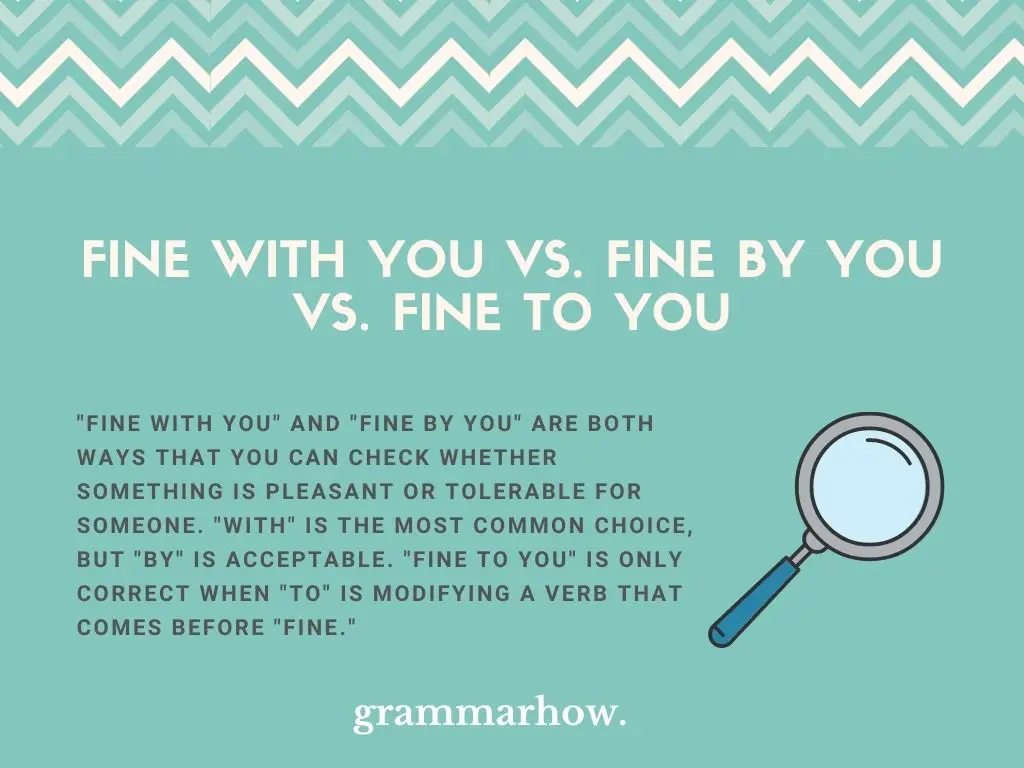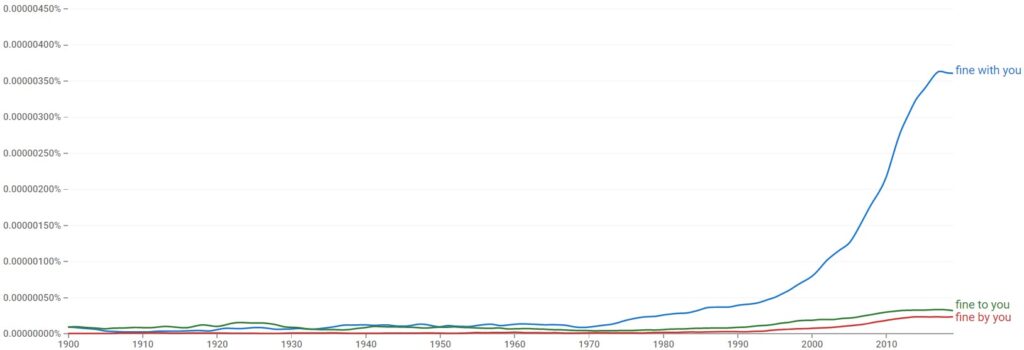Prepositions are finicky little things. They have the power to completely change the meaning of certain phrases, depending on how they’re used. This article will explore “fine with you,” “fine by you,” and “fine to you.” We’ll help you to understand the major differences.
Fine With You vs. Fine By You vs. Fine To You
“Fine with you” and “fine by you” are both ways that you can check whether something is pleasant or tolerable for someone. “With” is the most common choice, but “by” is acceptable. “Fine to you” is only correct when “to” is modifying a verb that comes before “fine.”

“Fine to you” is not interchangeable with the other two options. You cannot use it in the same way, like so:
- Correct: I hope this is fine with you.
- Correct: I want it to be fine by you, too.
- Incorrect: It is not fine to you, is it?
However, if you want to use “fine to you,” it’s appropriate to include a verb beforehand to make sure you know how “to” works with the rest of the sentence:
- That sounds fine to you, doesn’t it?
Fine With You
“Fine with you” is a great way of checking whether something is okay with someone else. It allows you to run it by them first to make sure that they are “fine” with the situation at hand.
“With” is the most common way of writing this phrase. It allows you to “check with” someone, where “with” is used when you’re referring to someone’s state of mind or satisfaction with something.
Knowing how to use “fine with you” in a sentence is simple when you refer to these examples:
- Is that fine with you? I thought I made all the appropriate arrangements to make sure you didn’t have to worry.
- If it’s fine with you, then I’ll get on with it right away. I wanted to check with you before I made any progress.
- If it’s fine with you, I’ll get to work immediately. I want to make sure that everything is in working order before I take any chances.
- It’s not fine with you, and that’s okay! I just wanted to make sure that we were both on the same page before I did anything stupid.
- Look, it’s fine with me. I am glad that you asked me first, but I don’t mind if you want to continue on with this without my input.
Fine By You
“Fine by you” is similar to “fine with you.” “By” can be used in place of “with” when you are checking that something is satisfactory for someone. “Fine by” is actually more common with the pronoun “me” because it allows you to state that something is fine.
You’ll often hear people say, “it’s fine by me,” rather than “it’s fine by you.” “Me” just feels more natural here compared to “you.”
If you want to know how to use “fine by you” in a sentence, you can refer to the following:
- I already know it’s fine by you, but I wanted to clarify a few things. I hope you’ll give me a few minutes to check whether this works.
- Is it fine by you if I go out with them tonight? I don’t want to do anything that might cause you to be a bit upset with me!
- It’s not fine by you, is it? You claim that everything is just fine, but I can tell that you’re not enjoying yourself right now.
- Trust me. It’s fine by me. Don’t bother asking me for help anymore. You just have to trust that you already know what you’re doing.
- If it’s fine by him, then it’s fine by me. I’ll make sure that I get all the work done correctly to make it all easier for you.
Fine To You
“Fine to you” is much more specific than the other two. It works best when a verb comes before “fine.” Something like “looks fine to you” is a good way of demonstrating how this might work.
“To” is used as a preposition to modify the verb here. It’s only common when someone is asking you whether something looks or sounds “fine.”
Here are some quick examples to help you understand how to use “fine to you” in a sentence:
- It sounds fine to you because you’re the one that made it. I can already notice a few errors that you haven’t picked up on.
- She looks fine to you, but I’m not sure I like her attire. I wish she would do something to change it up a little bit.
- If it looks fine to you, then it looks fine. I suppose you’re the best person to ask when it comes to this type of thing.
- It doesn’t seem fine to me. I’m sure there are a few things we can do to make sure this is operating at full capacity moving forward.
- Does it look fine to you? It doesn’t look like it’s going to last the next few hours, let alone the next few weeks!
Which Is Used The Most?
According to Google Ngram Viewer, “fine with you” is the most popular choice of the three. There’s almost no competition either, considering that both “fine by you” and “fine to you” are so low on the graph.

“With” is the most appropriate preposition to use in this situation. “Fine with you” is great to show that you are okay or satisfied with something.
“Fine by you” is only a substitute for “fine with you.” It’s not a common substitute, and “fine by” is often popular with the pronoun “me.”
“Fine to you” is very specific in its usage, which is why it’s not a popular choice.
Final Thoughts
“Fine with you” is the best way to write this phrase. “With” is the appropriate preposition because it checks whether someone is okay with the state of something. “Fine by you” can replace “with,” but it’s not common. “Fine to you” is a specific case that only works with verbs.
You may also like: “Fine By Me” vs. “Fine With Me” – Difference (With Examples)

Martin holds a Master’s degree in Finance and International Business. He has six years of experience in professional communication with clients, executives, and colleagues. Furthermore, he has teaching experience from Aarhus University. Martin has been featured as an expert in communication and teaching on Forbes and Shopify. Read more about Martin here.
